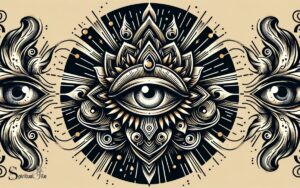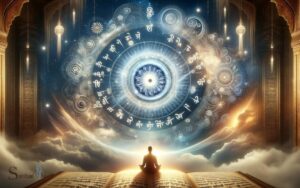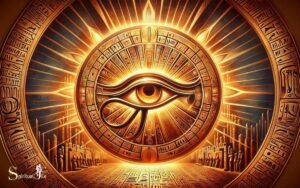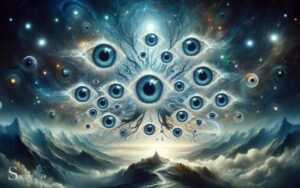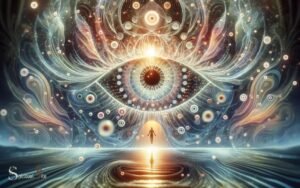What Does a Third Eye Mean Spiritually? Foresight!
The third eye is a spiritual and esoteric concept referring to an invisible eye which provides perception beyond ordinary sight.
In various spiritual traditions, it is associated with enlightenment and the ability to observe chakras and auras, among other metaphysical phenomena.
It symbolizes a state of enlightenment and the awakening of psychic abilities, representing intuition, foresight, and deep inner knowledge.
The concept of the third eye is most often found in Hinduism, Buddhism, and New Age spirituality.
It is typically located on the forehead between the eyebrows and is closely associated with the pineal gland, which is thought to be the biological counterpart of this spiritual eye.
The third eye is often seen as the gateway to higher consciousness and is a focus of meditation practices that aim to activate and develop one’s inner vision and intuition.
For instance, in Hindu tradition, the third eye is linked with the ajna chakra, which governs intuition and insight.
When the third eye is open, it is believed that an individual can see beyond the physical world, access psychic abilities, and gain profound understanding.
Embracing the third eye concept can catalze a transformative journey towards spiritual growth and an empowered, insightful state of being.
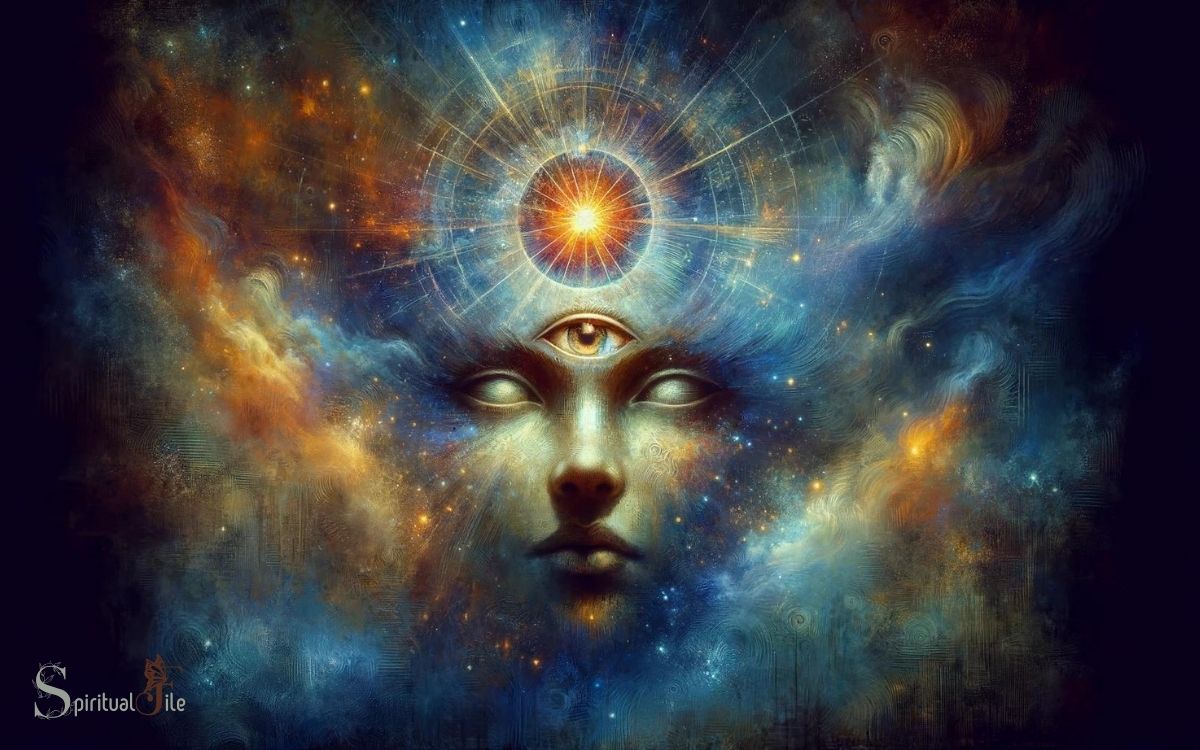
Key Takeaway
Origins of the Third Eye Symbol
The origin of the third eye symbol dates back to ancient Eastern spiritual philosophies. In these traditions, the third eye represents inner vision, intuition, and higher consciousness.
It is believed to be located in the forehead, between the eyebrows, and is associated with the sixth chakra, also known as the Ajna chakra.
The concept of the third eye is deeply rooted in Hinduism and Buddhism, where it is seen as a gateway to spiritual enlightenment and perception beyond ordinary sight.
The symbol of the third eye has since spread to other cultures and spiritual practices, gaining recognition as a powerful emblem of insight and awareness.
Its significance transcends religious boundaries and has become a widely recognized spiritual symbol in various parts of the world.
Cultural and Historical Significance
So, let’s talk about the cultural and historical significance of the third eye symbol. It’s fascinating to explore how different cultures have interpreted the concept of spiritual insight and awareness represented by the third eye.
From ancient civilizations to modern spiritual practices, the third eye holds cross-cultural significance and mystical interpretations worldwide.
Spiritual Insight Symbolism
One must explore the cultural and historical significance of spiritual insight symbolism to understand its profound impact on human consciousness.
Across various cultures and throughout history, the concept of the third eye has held deep spiritual meaning.
- In Hinduism, it is referred to as the Ajna chakra, representing intuition and perception beyond ordinary sight.
- Similarly, in Buddhism, the third eye symbolizes spiritual awakening and the ability to see the world beyond the limitations of the physical senses.
The ancient Egyptians also depicted the eye of Horus, symbolizing protection, health, and insight. These diverse cultural representations of the third eye demonstrate its universal significance as a symbol of spiritual insight and heightened awareness.
Understanding the historical and cultural contexts surrounding this symbolism enriches our appreciation of its relevance in today’s spiritual practices and personal growth.
Cross-Cultural Representations
Exploring the cross-cultural representations of the third eye reveals its deep historical and spiritual significance across diverse societies.
- In various cultures, such as Hinduism, Buddhism, and ancient Egyptian beliefs, the third eye is a symbol of inner vision, intuition, and enlightenment.
- In Hinduism, it’s associated with the Ajna chakra, representing the sixth primary chakra in the body.
- In Buddhism, it signifies spiritual awakening and the ability to see the world beyond physical limitations.
Ancient Egyptian depictions of the Eye of Horus also symbolize a similar concept of heightened perception and protection.
These representations showcase a common thread of spiritual awareness and insight transcending cultural boundaries.
The universal acknowledgment of the third eye’s significance underscores its timeless relevance in humanity’s quest for spiritual understanding and enlightenment.
Mystical Interpretations Worldwide
The third eye holds profound mystical interpretations worldwide, reflecting diverse cultural and historical significance.
- In various ancient cultures, including Egyptian, Hindu, and Buddhist traditions, the third eye is often depicted as a symbol of enlightenment, intuition, and spiritual awakening.
- In Egyptian mythology, the Eye of Horus represents protection, royal power, and good health. In Hinduism, the third eye of Lord Shiva symbolizes inner vision, wisdom, and the ability to see beyond the physical world.
- Similarly, in Buddhism, the concept of the third eye is associated with heightened consciousness and perception.
These mystical interpretations highlight the universal fascination with transcending ordinary perception and accessing deeper spiritual realms.
The third eye’s cultural and historical significance underscores its enduring relevance as a symbol of spiritual insight and enlightenment.
Third Eye in Eastern Philosophies
In Eastern philosophies, the concept of the third eye symbolizes inner intuition and spiritual insight. It represents the ability to see beyond the physical world and perceive the true nature of reality.
In Hinduism, the third eye is associated with the sixth chakra, often referred to as the ajna chakra, which is believed to be the center of intuition and foresight. This chakra is considered the seat of the mind and has a deep connection to one’s spiritual awareness.
In Buddhism, the third eye is linked to the concept of awakening and gaining insight into the nature of existence. It signifies the development of wisdom and the ability to see the world through a clear and enlightened perspective.
Across various Eastern philosophies, the third eye holds a profound spiritual significance, emphasizing the importance of inner vision and heightened consciousness.
Third Eye in Western Mysticism
Continuing from my previous discussion about the Third Eye in Eastern philosophies, my exploration of the spiritual significance will now delve into its relevance within Western Mysticism.
- In Western Mysticism, the Third Eye is often associated with the concept of inner vision, allowing individuals to perceive the hidden truths of the universe.
- This inner vision is believed to facilitate the understanding of divine mysteries and the exploration of higher spiritual realms.
- The Third Eye is also seen as a gateway to heightened intuition and psychic abilities, enabling practitioners to gain insight beyond the physical world.
- In Western esoteric traditions, such as Hermeticism and Kabbalah, the Third Eye symbolizes the awakening of spiritual consciousness and the pursuit of enlightenment.
Understanding the Third Eye in Western Mysticism offers a unique perspective on its role in spiritual development and the pursuit of transcendental knowledge.
Awakening and Balancing the Third Eye
As I explore the concept of awakening and balancing the Third Eye, it is important to understand the practices and techniques that can facilitate this process. Meditation plays a crucial role in awakening the Third Eye.
By focusing on the Ajna chakra located between the eyebrows, one can gradually open and activate this energy center.
Visualization exercises, such as envisioning a radiant indigo light at the Third Eye center, can also aid in its awakening.
Balancing the Third Eye involves harmonizing its energy with the rest of the chakras, typically through yoga, breathwork, and mindfulness practices.
Additionally, connecting with nature and spending time in silence can support the balancing of the Third Eye. It’s essential to approach this process with patience and an open mind, allowing the Third Eye to awaken and align naturally.
Spiritual Practices for Third Eye Activation
How can I incorporate spiritual practices for Third Eye activation into my daily routine?
Here are a few simple yet effective ways to work on activating and balancing your Third Eye:
- Meditation: Spend a few minutes each day in quiet meditation, focusing on the area between your eyebrows. Visualize a vibrant indigo light radiating from this point, and imagine it growing stronger with each breath.
- Yoga: Practice yoga poses that stimulate the Third Eye, such as child’s pose, forward bends, and inversions. These poses help increase blood flow to the area and promote energy flow.
- Crystals: Utilize crystals like amethyst, lapis lazuli, and purple fluorite, placing them on your Third Eye during meditation or carrying them with you throughout the day to support Third Eye activation.
Intuition and Inner Vision
When it comes to intuition and inner vision, developing a strong connection to the Third Eye is essential for spiritual growth and self-awareness. The Third Eye serves as the center of intuition and insight, allowing us to perceive the world beyond the limitations of the physical senses.
Through the activation and alignment of the Third Eye, individuals can access their inner wisdom, heightened awareness, and a deeper understanding of the interconnectedness of all things.
This heightened intuition enables us to trust our instincts, make better decisions, and navigate life with clarity and purpose. Cultivating this inner vision fosters a profound sense of self-trust and confidence in our spiritual journey.
By honing our intuition and inner vision, we can tap into the universal knowledge and experience a more profound connection with the divine. This connection paves the way for integrating the third eye in daily life.
Integrating the Third Eye in Daily Life
I’ve found that integrating the third eye into daily life can greatly enhance my spiritual awareness. By incorporating practical daily applications, I’ve been able to tap into a deeper sense of intuition and inner vision.
It’s amazing how this integration has brought a new level of clarity and insight into my everyday experiences.
Practical Daily Applications
Integrating the third eye in my daily life has empowered me to perceive subtle energies and gain deeper insights into my surroundings. This heightened awareness has allowed me to cultivate practical applications for enhancing my spiritual journey.
Here are some ways I’ve integrated the third eye into my daily life:
- Mindfulness Practices: Engaging in meditation and mindfulness exercises has helped me quiet the mind and attune to the wisdom of the third eye.
- Deepening Intuition: Tuning into my intuition has become a natural part of decision-making, guiding me towards choices aligned with my higher purpose.
- Enhanced Perception: I’ve learned to observe the world with heightened clarity, seeing beyond the surface to recognize the interconnectedness of all things.
These practices have not only deepened my spiritual awareness but also enriched my daily experiences, fostering a greater sense of harmony and purpose. This integration has truly become a transformative aspect of my life.
Enhancing Spiritual Awareness
Utilizing the third eye in my daily life has significantly heightened my spiritual awareness, allowing me to perceive subtle energies and gain deeper insights into the interconnectedness of the world around me.
By incorporating various practices into my routine, I have been able to enhance my spiritual awareness and connect more profoundly with the spiritual realm.
Here’s a simple comparison of how life changes when the third eye is integrated into daily living:
| Before | After |
|---|---|
| Limited awareness of energy flow | Heightened sensitivity to subtle energies |
| Occasional intuitive insights | Consistent and profound spiritual insights |
| Feeling disconnected from the world | Deep sense of interconnectedness and unity |
Integrating the third eye in my daily life has truly transformed my perception, allowing me to experience life with heightened spiritual awareness and a deeper understanding of the world around me.
Conclusion
As I reflect on the spiritual significance of the third eye, I am reminded of the lotus flower. Just as the lotus grows from the mud and rises above the water to bloom in the sunlight, our third eye represents the potential for inner growth and enlightenment.
By nurturing and balancing this spiritual center, we can open ourselves to deeper intuition and inner vision, allowing us to see the world in a new light.

